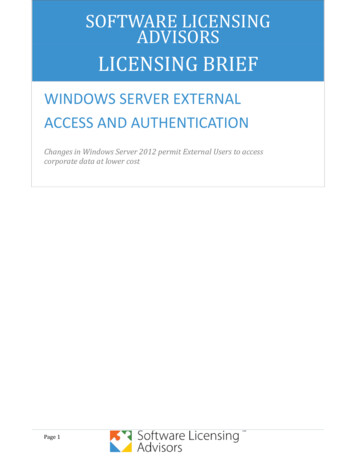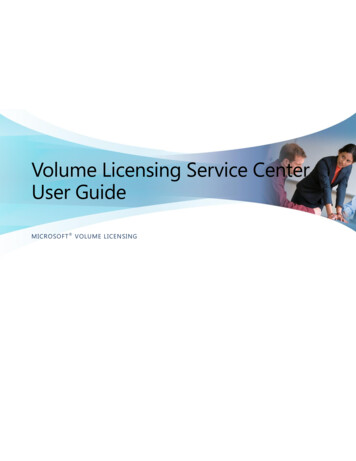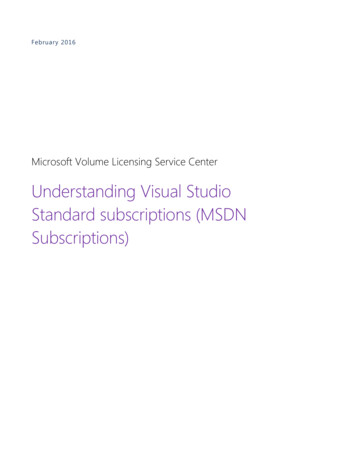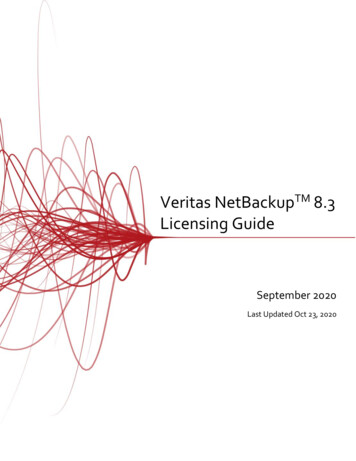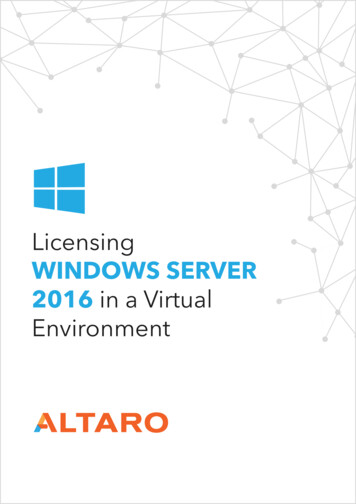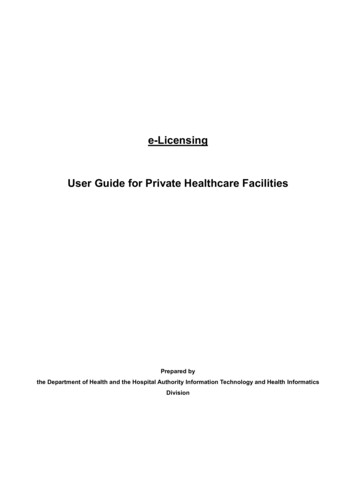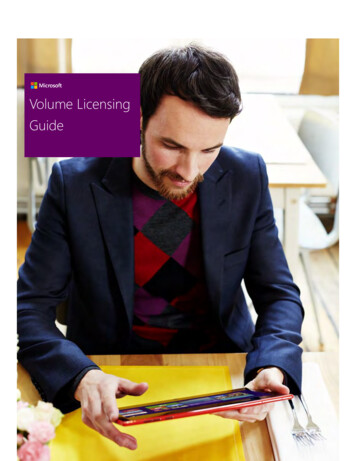
Transcription
Volume LicensingGuideiii
Table of contentsChapter 1: Introduction to Microsoft Volume Licensing .1How to use this guide .1Keys to understanding Microsoft Volume Licensing .1Programs for your organization type and size.2Programs for public sector and other organizations .3Microsoft Payment Solutions .4Chapter 2: Choosing a volume licensing program for your commercial organization .5Microsoft Open Programs .5Microsoft Open program family: Three options.6Microsoft Enterprise Agreement .8Microsoft Products and Services Agreement .15Microsoft Select Plus agreement.16Comparing Volume Licensing programs .19Taking the next step .20Chapter 3: Choosing a Volume Licensing program for your government organization .21Worldwide government licensing .21United States government licensing .21Home Use Program for government employees.22Choosing the right option .22Comparing Volume Licensing programs for government .24Taking the next step .25More resources .25Chapter 4: Choosing a Volume Licensing program for a nonprofit organization .26Transactional licensing .26How to acquire nonprofit discounts .27More resources .27Chapter 5: Choosing a Volume Licensing program for your school or university .28Transactional licensing .28Subscription licensing .29How to acquire academic discounts .30iii
Work at Home .30MSDN Academic Alliance membership .30Student licensing .31Taking the next step .31Chapter 6: Microsoft Volume Licensing programs for software and service partners .32ISV Royalty Licensing Program.32Resources .35Chapter 7: Using products licensed through a Microsoft Volume Licensing program .35Product licensing models.35Resources and tools.45Managing your licenses .45Chapter 8: Microsoft Software Assurance for Volume Licensing .48Software Assurance benefit eligibility .48Available benefits .49Acquiring Software Assurance .50Microsoft Open Programs and Software Assurance .50Microsoft Select Plus and Software Assurance .50Microsoft Products and Services Agreement and Software Assurance .51Microsoft Enterprise Agreement and Software Assurance .51Taking the next step .51iii
Microsoft Volume Licensing GuideChapter 1: Introduction to Microsoft Volume LicensingAcquiring software licenses through Microsoft Volume Licensing is different than acquiring retail boxed softwarelicenses. A retail software license is usually sold in a box and contains media (CD-ROM, or DVD format), a user’s guide,access to product support, and Microsoft Software License Terms. The Software License Terms dictate how you canand cannot use the software.Software acquired through Microsoft Volume Licensing is a software license only that gives you the right to run aMicrosoft software product. You can save above retail boxed software prices when you participate in a MicrosoftVolume Licensing program. By acquiring software licenses through Volume Licensing, you pay for only the softwarelicense and not for additional materials. With some Microsoft Volume Licensing agreements, you can also purchaseMicrosoft Software Assurance for Volume Licensing. This single, cost-effective program can help boost organizationalproductivity with support available 24 hours a day, seven days a week (24 7); deployment planning services; user andtechnical training; and the latest Microsoft software releases and unique technologies.When you acquire software through a Microsoft Volume Licensing agreement, you can choose to acquire media (orsupplemental media), documentation, and product support separately by download or physical media as needed.How to use this guideThis guide is an overview of the key features of Microsoft Volume Licensing programs. The information is presented byorganizational type and size—two of the most important keys to determining your best Volume Licensing option.The key chapters by organizational type are the following: Commercial business organization Government organization Nonprofit organization Academic organization Software and service partnersEach chapter also contains information about the additional benefits and resources that are available with eachagreement, such as software asset tracking tools, maintenance programs, and online management services. At the endof each chapter are a quick feature comparison chart and an online selection tool.In addition, separate chapters provide overviews of the following two key areas that apply to most Volume Licensingagreements in varying ways and are worthy of a more in-depth understanding: Product Terms (successor document to Product List and Product Use Rights [PUR]), which provide information aboutproduct availability across Volume Licensing programs and conditions on license acquisition in addition to productspecific terms and conditions that govern how Microsoft products can be used in the Volume Licensing programs Software Assurance, which helps you boost productivity across your organization by providing new product versions,deployment planning, support, training, and unique technologies in one cost-effective programKeys to understanding Microsoft Volume LicensingThe following are a few key organizational characteristics to consider that will help you understand Microsoft VolumeLicensing policies and agreements and help you choose the best option for your organization: The size and type of your organization The products that you want to license The way in which you want to use those products1
Microsoft Volume Licensing GuidePrograms for your organization type and sizeAt the most elementary level, Microsoft Volume Licensing agreement models address organizations in the followingtwo main categories: Organizations with 500 or more users or devices Organizations with 250 or more users or devices Organizations with more than 5 but fewer than 250 users or devicesFor organizations with 500 or more users or devices, Microsoft offers the following options: Microsoft Enterprise Agreement * offers the best value to large organizations that want a manageable volumelicensing program that gives them the flexibility to buy cloud services and software licenses under one agreement inresponse to the changing technology landscape. The Enterprise Agreement offers a subscription option, whichlowers initial licensing costs because you subscribe to the rights to use Microsoft products and services instead ofowning them. The subscription option lets you increase or decrease subscription counts annually. With thesubscription option you can access Microsoft software for as long as you maintain your subscription.*500 minimum user/device requirement is for commercial customers effective July 1, 2016. Does not apply to Server and CloudEnrollment (SCE). The minimum requirement for public sector customers is 250 users/devices. For more information, please see theEnterprise Agreement program guide.For organizations with 250 or more users or devices, Microsoft offers the following options: Microsoft Products and Services Agreement (MPSA) is recommended for midsize and large commercialorganizations that require 250 or more licenses for online services, software, and Software Assurance (optional) andthat do not want an Enterprise Agreement, or for organizations that are looking to make as-needed purchases. Microsoft Select Plus is for midsize and large organizations with 250 or more users or devices with multiple affiliatesthat want to license software and services at any business unit level while still getting the price saving advantages ofbeing a single organization.Select Plus is being retired, effective July 1, 2016, in markets where the MPSA is available, Microsoft will stop accepting neworders and Software Assurance renewals through existing commercial Select Plus agreements at your next agreementanniversary date. This retirement does not apply to government and academic Select Plus agreements. More information is atwww.microsoft.com/selectfaqFor organizations with fewer than 250 users or devices, the Microsoft Open agreements provide volume discounts fora minimal up-front cost and are widely available through the worldwide partner channel. Open agreements providethe following three purchasing license options for commercial businesses: Open License is for customers who want a minimum initial purchase of only five software licenses. This program isideal if you prefer to pay as you go and change your licensing agreement as your organization grows. You can alsoqualify for volume purchasing under the volume feature of Open License. Open volume purchasing is for customerswho can meet minimum purchase levels based on a system of product pools and points. With an entry minimum of500 points from a single product pool, this program offers deeper discounts for a greater savings. Open Value Subscription is for customers who want to subscribe to, rather than acquire, Microsoft product licenses.Available in select countries or regions, Microsoft Open Value Subscription provides the lowest up-front costs of theOpen options with the flexibility for customers to reduce their total licensing costs in years when their desktop PCcount declines. Open Value is for organizations with as few as five PCs and offers the advantages of Software Assurance, simplifiedlicense management, and an annual payment structure. Open Value offers Organization-wide and Non–Organizationwide options.In addition to size, consider your organization’s primary function. For example, special pricing is available forgovernment, academic, and nonprofit organizations.2
Microsoft Volume Licensing GuidePrograms for public sector and other organizationsFor public sector organizations with fewer than 250 users or devices, Microsoft offers customized versions of the Openagreements: Open License, Open Value, and Open Value Subscription. The Open License for Academic and OpenLicense for Government agreements are similar to commercial Open License, but with a single price level and differentpartner channels. In some countries or regions, government organizations can also participate in the Open Value forGovernment and Open Value Subscription for Government agreements. In some countries or regions, nonprofitorganizations can participate in the Open License for Nonprofit agreement. Check with your Microsoft Reseller foravailability.Government and academic organizations with 250 or more users or devices can participate in the Select Plusagreement. Government organizations can also participate in the Enterprise Agreement.For education institutions that prefer to license their software on an annual subscription basis, Microsoft offers twounique programs: Microsoft Enrollment for Education Solutions (for higher education institutions andprimary/secondary schools) and Microsoft School Enrollment (for primary/secondary schools only).Microsoft also offers programs that can meet the specific needs of organizations that partner with Microsoft toprovide additional software and services, such as the Microsoft Independent Software Vendor (ISV) Royalty Licensingand Distribution Agreement and the Microsoft Services Provider License Agreement (SPLA).Licensing on-premises softwareAnother key factor to consider—aside from organizational type and size—is which products and services you want tolicense. Different product families fall under different licensing models. For example, a desktop application, such as anyMicrosoft Office 2013 suite, requires a license for each device that is running the program locally or accessing theprogram on a network server. Customers can install any number of copies locally on licensed devices or on a networkdevice for remote use by licensed devices, but only one user can use the software on or from a licensed device at anyone time.A desktop PC operating system, such as the Windows 8.1 Pro operating system, requires a license for each devicerunning the product, and only one copy can be installed on the device.In Volume Licensing, the desktop PC operating system license is an “upgrade license.” You can acquire upgradelicenses only for devices for which you have already licensed a “qualifying operating system,” either preinstalled on aPC through a PC manufacturer or as full packaged product (FPP) from retail. The Product Terms shows the “qualifyingoperating systems” that qualify for an upgrade license and is available on the Volume Licensing website px.Meanwhile, server products are licensed by Server or by processor or core and, in some cases, by access points. Someserver products require a license for each running instance of the server software that you use on a server—whether ina physical or virtual operating system environment (OSE). Other server products require licenses for each physicalprocessor on the server or each core in the physical processors on the server. For example, a Windows Server 2012 R2Standard is licensed by physical processor and permits a running instance in up to two virtual operating systemenvironments, plus one host instance on the physical device solely to manage the virtual instances at a time on thelicensed server. Windows Server 2012 R2 Datacenter edition is also licensed by physical processor, but allows use ofany number of instances of the software.Windows Server as well as some of the server application products (e.g., Microsoft Exchange Server or MicrosoftSharePoint Server) require a Microsoft Client Access License (CAL) for each user or device that accesses the serversoftware. CALs are version specific and must be the same version or later than the server software being accessed.CALs permit access to servers licensed by the same entity. They do not permit access to another entity’s licensedservers.3
Microsoft Volume Licensing GuideLicensing Microsoft cloud servicesIn addition to traditional on-premises software licenses, Microsoft offers subscriptions to cloud services through theMicrosoft Online Subscription Program and the Microsoft Products and Services Agreement. How you add cloudservices through Volume Licensing depends on the following two factors: The type of Volume Licensing agreement that you have The date that specific cloud services are made commercially availableFor organizations with 250 or more users or devices, we recommend that you add Microsoft online services throughthe Microsoft Products and Services Agreement or through the Enterprise Agreement.* See Chapter 2 Choosing aVolume Licensing Program for Your Organization for more details. Smaller organizations should choose the MicrosoftOnline Subscription Program (MOSP) at www.microsoft.com/online.*500 minimum user/device requirement is for commercial customers effective July 1, 2016. Does not apply to Server and CloudEnrollment (SCE). The minimum requirement for public sector customers is 250 users/devices. For more information, please see theEnterprise Agreement program guide.Microsoft Payment SolutionsMicrosoft Payment Solutions provides commercial and public sector customers with an affordable and predictable wayto acquire the IT solutions that organizations want to help cut costs and increase efficiencies. Microsoft PaymentSolutions can help you focus on what matters most: finding the best IT solution to support the success of yourorganization.Microsoft works with multiple financing providers in 14 countries/regions around the world to offer financing solutionsunder the Microsoft Payment Solutions program. Our solution partners work with you to define your technologyrelated needs and objectives, set up a payment structure that works with your budget, and help you maintain cashflow.Microsoft Payment Solutions provides one financing resource for all your IT needs, including software, services, orproduct offerings. For organizations that already license software from Microsoft, flexible payment options areconvenient and allow you to spread out the costs of the licenses during an extended period of time, thus preservingcash resources.We offer a simple and easy method of lending without any additional fees. Typically, no down payment is required,and terms range from two to five years, making it easy to match your payments to your business operations andimmediately begin to realize IT benefits.Microsoft Payment Solutions helps you be strategic with your IT purchases in the following ways: Get the IT solution that you need to achieve business goals. Manage software, services (such as deployment), partner products, and hardware as one investment. Align IT benefits with costs. Enjoy a fast, easy, and responsive lending process.Find out how a predictable and affordable payment structure can help you get the IT you need and stay on budget.Visit the Microsoft Payment Solutions home page at www.microsoft.com/financing for more details.4
Microsoft Volume Licensing GuideChapter 2: Choosing a volume licensing program for yourcommercial organizationMicrosoft offers a variety of agreements to help businesses of all sizes manage how they purchase software licenses.These agreements cover everyone, from smaller organizations with a handful of desktop PCs to multinationalorganizations that manage tens of thousands of client and server units.Volume discounts are the most obvious benefit of these agreements. But Volume Licensing also helps organizationswith the following tasks: Tracking software use to ensure legal compliance Deploying updates and new versions, especially on desktop PCs Organizing software license purchasing through centralized purchasing practicesIn general, Microsoft Volume Licensing commercial agreements align to two main categories: those for companieswith fewer than 250 users or devices and those for companies with 250 or more users or devices.For organizations with up to 250 users or devices the Microsoft Open agreements—Open Value, Open ValueSubscription, and Open License—have flexible, low-entry requirements. Open agreements offer three choices to meetan organization’s specific needs, and they are all available from resellers, solution providers, and online vendors.For organizations with 500 or more users or devices, Microsoft offers the Microsoft Enterprise Agreement.* Fororganizations with 250 or more users or devices, Microsoft offers the Microsoft Products and Services Agreement,Microsoft Open Value, Open Value Subscription, and Select Plus (being retired effective July 2015). These options areavailable through Microsoft Licensing Solution Partners (LSPs) and Microsoft Enterprise Software Advisors (ESAs). BothLSPs and ESAs offer flexibility in payment schedules.All organizations can also subscribe to online services through the Microsoft Online Subscription Program or throughthe Microsoft Products and Services Agreement.*500 minimum user/device requirement is for commercial customers effective July 1, 2016. Does not apply to Server and CloudEnrollment (SCE). The minimum requirement for public sector customers is 250 users/devices. For more information, please see theEnterprise Agreement program guide.Microsoft Open ProgramsOrganizations with fewer than 250 users or devices1Open Program offerings are a convenient and simple way for corporate, academic, charity 1, and government22organizations with at least 5 desktop PCs to acquire the latest Microsoft technology. These offerings provide volumediscounts for a minimal up-front cost and are available broadly through a worldwide partner channel. AlthoughMicrosoft Open Programs are available to any size organization, they are most often used by organizations with fewerthan 250 users or devices. The Open Programs offer many benefits, including the following:Simplicity. Start using licensed products as soon as your order is placed through the Open License pay-as-you-gomodel. 1Not available for charitable organizations in all countries/regions. Check with your reseller regarding current availability.2Open Value for Government is an option for government organizations with up to 250 users or devices.5
Microsoft Volume Licensing Guide Affordability. All Open Programs offer flexible payment options so that you can stretch your software procurementbudgets further than you can with retail license purchase options. Flexibility. A broad worldwide partner channel ensures that you have convenient and fast access to thousands ofsoftware titles. Value. Manage licenses easily and conveniently through the Microsoft Volume Licensing Service Center (VLSC).Microsoft Open program family: three optionsThere are three options available through the Microsoft Open program: Open Value (Organization-wide or Open ValueNon–Organization-wide), Open Value Subscription, and Open License.Open ValueThe Open Value program is a flexible and affordable way to use and manage Microsoft licensed products under asingle agreement. The program is a three-year term commitment that includes Software Assurance as a fixed benefit.The Open Value program has the following options from which to choose.Organization-wide option (5 qualified devices minimum)Open Value Organization-wide offers commercial and government organizations additional savings for standardizingall of their desktop PCs on one or more Microsoft enterprise products. With this single platform option, you cancustomize your desktop PCs by choosing separate components, including the desktop operating system, MicrosoftOffice suites, and CAL Suites, plus additional software products selected in your agreement that include the followingplatform product options: Desktop operating system: Windows Pro Upgrade and Windows Enterprise Upgrade Microsoft Office suite: Microsoft Office Professional Plus CAL Suites: Microsoft Core CAL Suite, Windows Small Business Server CAL Suite, and Enterprise CAL SuiteThe Open Value Organization-wide option includes discounts on company (organization)-wide deployment.Non–Organization-wide option (5 qualified devices minimum)If you need licenses for servers or for a limited number of desktop PCs, you can open a Non–Organization-wideAgreement for any product license purchases.Open Value Subscription (5 qualified devices minimum)Open Value Subscription offers flexible annual payments tied to the number of desktop PCs you have and the lowestup-front costs. The benefits include: Additional savings in the first year if you have current or previous versions of organization-wide licensed products. The option to add the organization-wide licensed products that you have selected on new desktop PCs throughout theyear at no additional cost for that year. Lower payment through the years as your desktop PC count declines.Like the organization-wide option, the Subscription option offers the Single-Platform option to standardize desktopPC software across your organization with a customizable platform that allows you to mix and match components.Platform optionWith both Open Value organization-wide and Open Value Subscription, you can choose to standardize desktop PClicensed products across your organization on all three components on the platform (desktop operating systems,Microsoft Office suites, and CAL Suites) and receive additional savings. The platform option provides the simplest wayto manage desktop PC licenses because you do not need to track which version is installed on which desktop PC.6
Microsoft Volume Licensing GuideOpen LicenseOpen License is a two-year term commitment that is ideal for organizations that want a minimum initial purchase offive software licenses. This program is also great for a growing organization’s changing business needs because itoffers a pay-as-you-go model.Open License volume purchase option: If you are p
Microsoft Volume Licensing Guide . 1 . Chapter 1: Introduction to Microsoft Volume Licensing . Acquiring software licenses through Microsoft Volume Licensing is different than acquiring retail boxed software licenses. A retail software license is usually sold in a box and contains media (CD-ROM, or DVD format), a user's guide,
